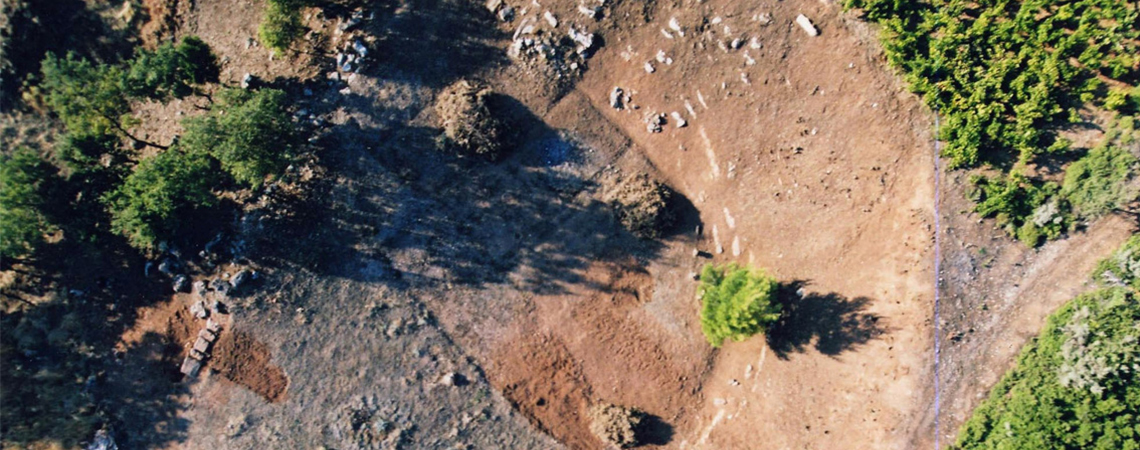
The theater of Keryneia is located in the N-E limits of the ancient city, at the position Paliomylos.
It was spotted by Meyer in 1939, as the retaining wall of the stage to the West and part of the cavea was visible, although covered by soil up to around 2.50m. high at its lowest point. The monument was positioned in such way so that its cavea would overlook to the West, through an open horizon towards the valley of Kerynitis River, for obvious reasons of better acoustics.
Extensive cleansing from the surface vegetation and a section that was opened in 2001 gave us details of its size and conservation status. The cavea’s diameter is estimated at 44m. while its seat rows were possible as many as 25. The seats consist of extremely fragile sandstone, and are 0.35 – 0.40 m. wide, as is the area of their base which consists of pressed soil. The section revealed a part of the stairway with stairs made of sandstone, which are 0.35 to 0.50 m wide and 0.22 – 0.23 m. high. In the lower row parts of two VIP thrones were revealed, also made of sandstone
Theater of ancient Keryneia (Mamousia)
Theater
The theater of Kyrenia was spotted by Meyer in 1939, as the retaining wall of the stage to the West and part of the cavea was visible, although covered by soil up to around 2.50m. high at its lowest point. Extensive cleansing from the surface vegetation and a section that was opened in 2001 gave us details of its size and conservation status.
The theater was photographed after its cleaning from the vegetation in 2001. Aerial photographs have also been taken in the context of the project “Regeneration and enhancement of the archaeological site of ancient Kyrenia (Mamousia) in the prefecture of Achaia” (3rd CSF). The excavation section in the cavea has been also photographed and sketched.
The asrchaeological site of Keryneia is located at the Paliomylos position, north of the municipal district of Mamousia in the municipality of Aigialeia (prefecture of Achaia).
Based on the few dating evidence available, the monument dates from the Hellenistic period (3rd – 2nd century BC).
The theater of Keryneia is located in the N-E limits of the ancient city, at the position Paliomylos.
It was spotted by Meyer in 1939, as the retaining wall of the stage to the West and part of the cavea was visible, although covered by soil up to around 2.50m. high at its lowest point. The monument was positioned in such way so that its cavea would overlook to the West, through an open horizon towards the valley of Kerynitis River, for obvious reasons of better acoustics.
Extensive cleansing from the surface vegetation and a section that was opened in 2001 gave us details of its size and conservation status. The cavea’s diameter is estimated at 44m. while its seat rows were possible as many as 25. The seats consist of extremely fragile sandstone, and are 0.35 – 0.40 m. wide, as is the area of their base which consists of pressed soil. The section revealed a part of the stairway with stairs made of sandstone, which are 0.35 to 0.50 m wide and 0.22 – 0.23 m. high. In the lower row parts of two VIP thrones were revealed, also made of sandstone
The seats, the stairs and VIP thrones in the cavea are all made off the extremely weather-sensitive local sandstone. Because of the altitude of the ancient city (750m), weather is intense in winter, causing significant damage to sandstone monuments, which are converted into sand. Taking this into consideration and after consulting with the Center of Stone we proceeded to the filling of the section in the cavea and did not continue the excavation of the theater.
A section was opened vertically into the cavea and the orchestra in 2001.
The monument can not be used for performances or other events, since its excavation has not proceeded, due to its poor conservation status.
Visitable site
The ancient theater can be visited. It is located at the very center of the archaeological site of ancient Keryneia, which emerged under the 3rd CSF. The path that crosses the ancient city runs from its eastern extremity.
Ministry of Culture & Tourism / 6th Ephorate of Prehistoric and Classical Antiquities
Ministry of Culture & Tourism / 6th Ephorate of Prehistoric and Classical Antiquities
38.162201°
22.146624°